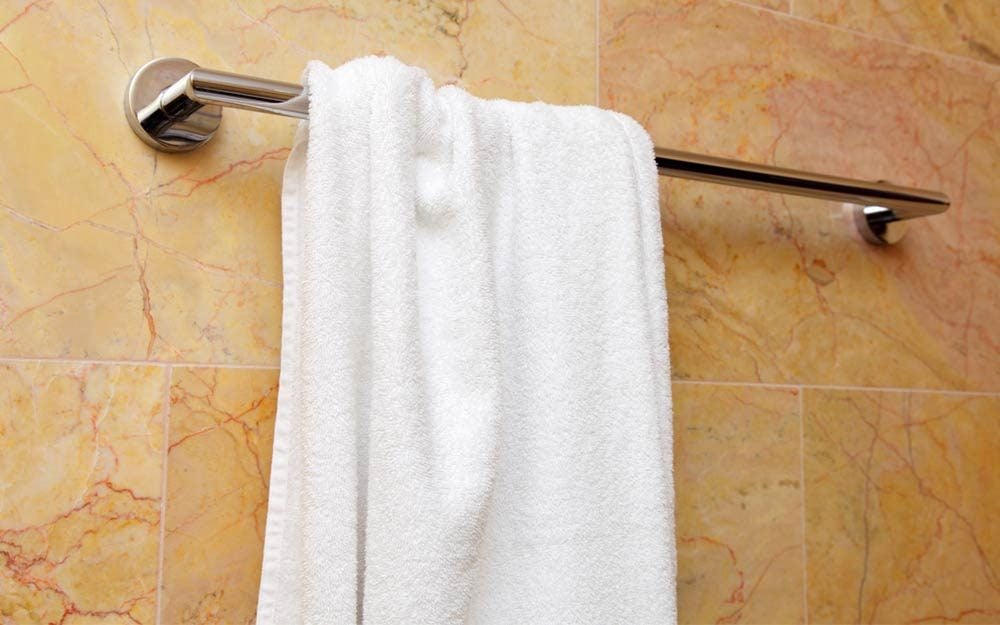
This is How Often You Should Wash Your Bath Towels
You only use your bath towel after scrubbing off in the shower, so it can’t get all that dirty, right? Not so fast. “When you say you wash off bacteria, you’re partially correct—you wash off some bacteria,” says Philip Tierno, PhD, clinical professor of pathology and microbiology at NYU School of Medicine. But others will stick around, and they get on your towel during your post-shower rubdown.
Once those bacteria are on on your towel, they’ll start to multiply. “It keeps building up as you use the towel again day after day,” says Chuck Gerba, PhD, a microbiology professor at the University of Arizona. A study led by Dr. Gerba found that used hand towels have 1,000 times more coliform bacteria than newly bought ones. Bacteria love dark, moist environments, so they’ll thrive in a steamy bathroom with the door closed.
Surprised? Here are more everyday items that are dirtier than a toilet seat.
The Worst Case Scenarios: Infection and Acne
Rubbing down with a dirty towel, and you could be at risk for infection. “When you use a towel vigorously, you scratch your skin,” says Dr. Gerba. Those tiny breaks in your skin—which are too small to notice—give bacteria an entryway to get in your body.
Still, it’s “extremely unusual” to actually pick up a disease from your bath towel, says infectious disease specialist Aaron Glatt, MD, FACP, FIDSA, FSHEA, spokesperson for the Infectious Diseases Society of America and chairman of medicine and hospital epidemiologist at South Nassau Communities Hospital. Your own germs won’t make you sick, but you increase your chance of picking up a disease when you share towels, says Dr. Gerba.
If you’re acne-prone, you might want to wash your towel every time you use it, says Dr. Tierno. As you rub your skin—especially open pustules—with a dirty towel, bacteria could get on your skin and give you zits. (Here’s what causes adult acne—and what you can do to get rid of it.)
How to Keep Towels as Clean as Possible
Even if you don’t let anyone else touch your towel, Dr. Gerba and Dr. Tierno recommend you wash bath towels every two or three days. Hold out longer than that, and all those microorganisms will make your towel grungy. “You may not get sick after using a towel for two weeks, but that’s not the point,” says Dr. Tierno. “Would you put on dirty underwear (unless there’s an emergency) after you’ve taken a clean bath? It’s very similar to what you’re doing after the first couple of drying episodes.” These brilliant laundry hacks will make washing towels less of a chore.
Between washes, cut down bacteria growth by letting your towel air-dry fully, says Dr. Tierno. Instead of folding it, drape open on the rod. The more surface area is open to the air, the better it will dry. If you have a heated towel rack that speeds up dry time, you might only need to wash after four uses—but that’s “pushing it,” says Dr. Tierno. (While you’re at it, this is how often you should wash your bed sheets.)
Even though you might need to do more laundry, don’t get lazy. Bacteria aren’t in a rush to leave a thick cotton towel. “It’s really hard to clean those towels,” says Dr. Gerba. “Even with hot water, you have to go through a full cycle to remove them all.” Once it’s out, leave it in the dryer for at least 45 minutes to make sure all the moisture is gone, he says. Now that you know how often to clean your towels, learn how to clean the 16 other dirtiest items in your home.

Everyone who has ever flown coach knows what it feels like to walk down the aisle of the plane, past the roomy first-class seats and past the seats with extended leg room, all the way to the back. You envy the people that are going to have a more comfortable flight than you. But, on very rare occasions, airlines will call passengers at the gate and offer them an upgraded seat. If you’ve ever been lucky enough to get upgraded, you know how much nicer it makes your travels. There are a few things you can do to increase your chances of getting picked and don’t worry, you won’t have to pretend that you’re on your honeymoon.
The travel expert for NerdWallet, Sara Rathner, says that flights are so often overbooked or full that just dressing up and being friendly to the gate agents isn’t going to get you an upgrade despite what some people might say. “You can increase your odds of an upgrade by flying one airline exclusively, and even signing up for that airline’s co-branded credit card because both allow you to rack up the qualifying miles needed to gain elite status.” The higher you move up in status, the more perks you get. Some of those perks include priority boarding, free checked bags, and seat upgrades. (Here’s why airlines never tell you how long flights really are.)
Even though you’re more likely to find better deals shopping around different airlines every time you fly, consistently booking with the same airline can save you money in the long run, especially if you’re a frequent flyer.
Extensive flyer Nick Brennan also agrees that loyalty to one airline has its perks. “If you’re loyal to one airline, then your loyalty is also recognized across that airline alliance when you travel on international flights,” he shares. “If there’s an operational reason to upgrade passengers (i.e. a delayed or cancelled flight), then your loyalty will be recognized before others who mix and match their flights and airlines and show no obvious loyalty.” (This is the one word you need to say to get your flight attendant to like you.)
Another tip Brennan has for scoring an upgrade on a flight is to be flexible. If you’re not in a rush to get anywhere and the weather is bad or your flight is overbooked, ask the gate agent what they can offer you if you’re willing to catch a different flight. With some negotiation, they can typically offer you a seat upgrade as well as cash.
Next, find out the secret phrases pilots say.

In 2018 and 2019, President Donald Trump met with Queen Elizabeth II, making President Trump the 12th sitting president to meet with Her Majesty. Beginning with her meeting with President Harry Truman in 1951 (she was still a princess at the time) her role in diplomatic relationships between the United States and the United Kingdom cannot be understated. However, one president since then has been left off this list—but why?
In 1957, five years into her reign, Queen Elizabeth met with President Dwight D. Eisenhower, and in 1961, she hosted President John F. Kennedy and First Lady Jackie Kennedy at a state visit at Buckingham Palace held in the president’s honour. That in and of itself was quite the event—here’s what really happened when Jackie Kennedy met Queen Elizabeth. After the Queen hosted President Richard Nixon in 1960, she visited the White House in 1976 to meet with President Gerald Ford and hosted President Jimmy Carter at Buckingham Palace a year later.
In 1982, President Ronald Reagan visited the United Kingdom, and the Queen returned the favour a year later when she attended a State Dinner with President Reagan in San Francisco. The Queen visited the United States again in 1991 to meet with President George H. W. Bush, and in 1995, President Bill Clinton and First Lady Hillary Clinton visited Buckingham Palace. The Queen met with the Clintons again in 2000. President George W. Bush met with the Queen in the United Kingdom in 2001 and 2003, and at the White House in 2007. President Barack Obama and First Lady Michelle Obama met with the Queen several times during his presidency, and in 2009, made headlines with some broken royal protocol: the hug heard ’round the world. President Trump has now met with the Queen twice. But, did you notice we left one name off this presidential list? What happened with President Lyndon B. Johnson?
It turns out, the Queen’s youngest son, Prince Edward, is to blame. Although Her Majesty likely would have met President Johnson if she had attended President Kennedy’s funeral, those plans had to be scrapped as Queen Elizabeth was pregnant with Prince Edward at the time.
Surprised by this piece of trivia? Make sure to read on for these myths about Queen Elizabeth.

In a pinch, they seem interchangeable. If a recipe calls for stock, you can usually use broth. If a recipe calls for broth, you can usually use stock. Not to mention, there’s really no difference between stock and broth when it comes to how they look, and they taste similar too. But what, exactly, is the difference between broth and stock? Before you use the terms interchangeably, check out our primer below.
What is stock?
Traditionally, stock was made using the bones of an animal like a chicken. Chefs would simmer the bones with something called “mirepoix,” which is a mixture of onions, carrots, and celery. No meat is necessary to make stock, but it can include meat as well. The most important component is the bones. Stock usually cooks for around two to six hours. (You’re wasting your money if you throw out these 10 cuts of meat.)
So, just for the record, bone broth is not a broth at all. Bone broth is much more similar to stock than to broth, which is thoroughly confusing. Bone broth is different, though, because it cooks longer than either stock or regular broth—it’ll usually be on the stove for at least 12 hours, per the kitchn.
What is broth?
Broth is a cooking liquid made by simmering meat, also often with mirepoix. Bones are to stock as meat is to broth. It’s essentially the reverse of stock—though bones can be included, they don’t have to be, and broth is primarily made with meat. Broth usually cooks for a shorter time than stock (under two hours, per the kitchn).
The use of meat rather than bones is still the biggest difference between broth and stock when it comes to chicken. When it comes to vegetables, Fine Cooking claims that there is no difference between vegetable stock and vegetable broth, because vegetables don’t have bones—or meat. (Find out how long your fresh produce will really last.)
What’s the difference between stock and broth?
So the biggest difference ultimately comes down to ingredients; chicken broth would be made with the actual meat of the bird, while chicken stock would be made from the bones and the trim of the animal. Another difference between stock and broth is that broth is usually seasoned, while stock has no seasoning in it, according to the kitchn.
Taste-wise, broth tends to be a bit more rich, while stock will have a fuller, more pillowy mouthfeel. Stock also takes longer to make than broth, since it takes quite a while to release all the gelatin and collagen present in the bones used while releasing all the flavour out of meat is a bit quicker of a process. So, no, stock and broth are not the same!
You’ll wish you knew these brilliant cooking shortcuts sooner!

Do you really need to refrigerate butter?
Butter can make even the blandest piece of toast taste good. But, when you cut some from a rock hard stick of butter it isn’t easy to spread and can end up ruining your breakfast. So, is it safe to keep your butter out of the fridge so that you can easily spread it on your toast in the morning and get out the door?
You’re probably thinking, “Butter is dairy, there’s no way I can leave it out on the counter.” You’re actually wrong; you don’t need to refrigerate butter. The USDA listed butter as the only dairy food that is safe to keep in a power outage.
You would never keep milk out on the counter, so what makes it OK to keep butter out? They’re actually made very differently and that makes butter much less likely to attract bacteria. Butter is about 80 per cent fat, which makes its water content much lower and therefore less likely to have bacteria when left out. Butter is also often made with pasteurized milk, which makes it less prone to bacterial growth. The salt in your butter also wards off bacteria growth—but, if you have unsalted butter, it’s best kept in the fridge. Get the scoop on why North Americans refrigerate eggs and Europeans don’t.
If your butter is kept in an airtight container, or in a butter tray with a top, it will stay good for about a week. They key is to not expose it to oxygen or light. Only leave a small amount of butter out at a time so you don’t have to throw away what you don’t use after a week.
So, there you have it, you don’t need to refrigerate butter—or these 20 other foods for that matter. You can say goodbye to dented bagels from trying to spread cold butter on them. Now your breakfast can be made in a flash!
[Source: Simplemost]
Next, find out 12 tricks to keep fruits and vegetables fresh longer.
What are whiskers?
Even if you don’t have a pet, you probably have a basic idea of what whiskers are. Even as a little kid, if you were sketching a dog or cat, you made sure to draw the little lines sticking out from its nose. But why do dogs have whiskers? No, they aren’t extra-long facial hairs, like the dog version of a mustache. The purpose of dog whiskers is something totally different. Whiskers, also known as “vibrissae,” are the coarse hairs around dogs’ noses and jaws, and above their eyes as well. To be exact, “whiskers are specialized hairs that are tied to sensory nerves around a dog’s face,” explains Dr. Jennifer Coates, Chewy vet expert. Cats, rabbits, rats, and lots of other animals have whiskers as well.
Why do dogs have whiskers?
So what do dog whiskers do? It turns out that they play a crucial role in the way dogs approach the world around them. Different from ordinary hairs, the hair follicles at the base of whiskers are equipped with nerves. So whiskers are very sensitive to everything from physical objects to shifting air currents. When whiskers come into contact with something, the nerves send signals to the dog’s brain, allowing the dog to evaluate what’s close by. “A dog’s whiskers can help them sense a nearby object, even in the dark, before they bump into it and potentially injure themselves,” Coates explains. It’s similar to the way humans feel things (especially when visibility is poor) with their hands. (Find out all the ways dogs are smarter than you think.)
This is a particularly important function for a couple of reasons. Firstly, dogs’ vision is not a strong a sense as vision is in humans—their sense of smell is much more adroit—especially when it comes to close-up vision. And, of course, dogs don’t have hands—they have four legs. So whiskers serve a major purpose in helping dogs discern what’s in front of and around them.
What else do dog whiskers do?
Is there a purpose of dog whiskers besides helping dogs feel things around them? Well, that is the primary purpose. But another answer to the question “why do dogs have whiskers” involves how the dog is feeling, and how they show it. “Dogs also appear to use their whiskers to convey their state of mind,” Coates told RD.com. “For example, when a dog is alert and engaged with their surroundings, their whiskers tend to be upright, while the whiskers on a reserved or timid dog often will be held close to the face.” A dog that feels threatened may “flare” its whiskers and then point them forward as an instinctual defensive reaction. Your dog’s tail has plenty of things it can tell you, too.
Should you cut your dog’s whiskers?
Now that you know what dog whiskers are for, you may be wondering if it’s OK to cut them. Trimming whiskers won’t hurt the dog, since whiskers don’t contain pain receptors, nor is it permanent because whiskers will grow back. But losing part or all of their whiskers can alter your dog’s spatial awareness, which can lead the dog to become confused and disoriented.
Next, learn the signs your dog is secretly mad at you.

It’s early morning in Cape Spear, N.L. A van heads toward the area’s iconic lighthouse as the sun climbs out of the Atlantic. The vehicle is full, but not with eager tourists hoping for a sunrise selfie. It’s packed with photographers and crewmembers on their way to meet mermen. “MerB’ys,” actually. The water dwellers are ready for their close-ups. And they look flipping fantastic.
This marks the second year that a group of bearded Newfoundlanders have shed their shirts and pulled on tails to pose as misters March, December and company. Their mission: making a sassy calendar to support a worthy cause. The first edition, in 2017–18, sold more than 14,000 copies and raised $300,000 for Spirit Horse NL, an organization that uses equine-assisted therapy to support people living with mental-health issues.
The tidal wave of interest in the calendar still surprises organizer Hasan Hai. “This all started when a friend posted a photo of a bearded merman on my Facebook page and wrote, ‘You should do a thing,’” says Hai, who also founded the Newfoundland and Labrador Beard and Moustache Club, a social group. “When I put out an open call, I just thought it’d be me and a few random guys.” But 40 people followed up, and two months later there was a calendar.
The funds donated to Spirit Horse NL help people like Jennifer Mercer, who contacted the charity’s founder, Erin Gallant, while struggling with deep depression. “I couldn’t motivate myself to get out of bed,” she says. “At first, I was afraid of horses, but then you connect with them and they make you feel so comfortable. I don’t know where I’d be without them and my work with Erin. I give thanks every day.”
With this year’s calendar, Hai wants to raise even more money and further challenge people’s notions of what constitutes masculinity: “There’s a very narrow slot in which it’s deemed okay to be a man, and that’s so harmful,” he says. The 2019 MerB’ys are a bigger gang—38 in total—and they’re more diverse, with different gender identities, sexual orientations, body types, abilities and backgrounds.
The group has also expanded its reach. Hai and some of his crew drove their “Mermob’ile” from St. John’s to the west coast of Newfoundland, then flew to central Labrador to connect with men across the province. In Twillingate, they met Mark. “He broke down in tears talking about growing up in rural Newfoundland, where men had to act a certain way,” remembers Hai. “He said he was doing this for his seven-year-old son, to show him that men could be different, that they can be emotional. And his son said, ‘Dad, I’m so proud that you’re a MerB’y.’”
Using a mythological creature to challenge myths about masculinity has proven to be a powerful idea. Money raised this year will kick-start Deconstructing Masculinity: Engaging Men in Violence Prevention, a new program led by Violence Prevention NL, a coalition of 10 Newfoundland and Labrador-based organizations.
“Violence prevention has often been seen as a women’s issue, and I don’t think that’s the right way to look at it,” says Kevin O’Shea, the executive director of the Public Legal Information Association of NL, who is involved in the new initiative. “The only way we’re going to be effective at prevention is to look at the mindset and culture that causes violence, to involve men and boys and to work collaboratively toward change.”
Hai is eager to continue playing a role in changing attitudes and encourages others to get involved in their communities: “Positive change starts with the tiniest thing—literally saying a kind word to someone,” he says. “Just do something different, just keep pushing forward, and eventually you’ll realize you’ve done something really grand.”
For more heartwarming stories, read about the calendar designed to help Canadian veterans.
Brad Rutter: $4,688,436
Brad Rutter remains the all-time biggest winner of Jeopardy! according to the game show’s Hall of Fame. His total winnings, including tournaments, of more than $4.5 million, were accumulated over 14 years beginning in 2000 when he was just 22 years old. At that time, contestants could win a maximum of five consecutive games. Rutter has never lost a Jeopardy match to a human. After congratulating James Holzhauer on his epic run he tweeted, “I’m a little bummed to no longer be the “@Jeopardy champion personally recognized by the most Las Vegas casino employees.”
Ken Jennings: $3,370,700
Ken Jennings is the second largest all-time winner earning $3,370,700. He also holds the record for winning the most consecutive games (74) and the highest winnings during regular season play ($2,520,700). Jennings notes that a recent rule change that allowed contestants to remain on the show indefinitely permitted him to dominate air time for six months. He ultimately lost the show on a question about H&R Block.
James Holzhauer: $2,464,216
The professional sports gambler from Las Vegas created a new level of buzz for Jeopardy! keeping viewers glued to the screen during his 32-week run. He trails Jennings by just $58,484 for highest winnings in a regular season, a feat he accomplished in 32 games compared to Jennings’ 74 game run. He also holds all 10 spots for single-game winnings consistently breaking his own records with his top high win of $131,127. His signature strategy of betting on top dollar amounts first, waging amounts related to important personal dates, and betting big on the Daily Double served him well.
Dave Madden: $773,733
Dave Madden’s total winnings of $773,733 puts him in fourth place of all-time Jeopardy! winnings. He is third in regular season winnings at $430,400 winning 19 games in 2005. After his stint on the show, the art historian hiked the length of the United States for the Fisher House Foundation. The founder and Executive Director of the National History Bee and Bowl, Madden, like Holzhauer, hunted for the Daily Double.
Larissa Kelly: $660,930
Along with being the top woman money winner ($660,930) on Jeopardy!, Princeton graduate Kelly was the first woman to win five consecutive games in a row. Kelly’s husband and sister also were on contestants on Jeopardy! Kelly and fellow Princeton grad Dave Madden appeared in Jeopardy! All-Star Games. These are the Jeopardy! categories that trip the most people up.
Matt Jackson: $611,612
Back in 2015, Matt Jackson won 13 consecutive games, putting him in fifth place for consecutive games won as well as number five for highest winnings in a regular season of $411,612. The Yale graduate was just 23 years old when he played in 2015 and was best known for his rapid responses and quirky expressions like yelling “Boom!”
Roger Craig: $530,200
Back in 2010, Roger Craig trumped then single-day winner Ken Jennings by winning $77,000 in his six-day winning streak. Fast forward to 2019, when phenom James Holzhauer dethroned Craig by winning $110,914. Craig currently is number ten for highest single day win in a regular season of $230,200. Meanwhile, Holzhauer broke his own record three more times. (Try these memory-boosting tricks from a Jeopardy! contestant.)
Colby Burnett: $480,334
Colby Burnett, a Jeopardy! winner of $480,334, has the double distinction of 2012 Teachers Tournament and 2013 Tournament of Champions winner. The Chicago native and college counselor at Speer Academy is involved in the national trivia community. At the time of his victories, he was an AP History teacher at his Alma Mater Fenwick High School and said he would help his mother buy a house if he won $100,000.
Julia Collins: $478,100
CEO and Founder of Girls Like Me Julia Collins is a leading lady in two categories: She won 20 consecutive games in 2014 and has the highest winnings for a female in regular season raking in $428,100. The champion is ranked number three in consecutive games, number four in regular-season play and number nine in all-time winnings (including tournaments) for her total winnings of $478,100. She lost on a question about Oscar-winning writers whose correct answer was New England writer John Irving.
Austin Rogers: $461,000
Animated contestant Austin Rogers was best known for his pantomimes and energy. Tenth in all-time winnings (including tournaments) for his total of $461,000, he also is number six in the consecutive game wins for his 12-game streak in 2017 and also is in sixth place for highest winnings (regular season play) at $411,000.
Next, find out why Alex Trebek has never wanted to retire.

1. Eastern bluebirds are particular about the homes they raise their young in. They like snug boxes with a four-inch-square base and a 1¾-inch-diameter entry hole.
2. True to their name, some mountain bluebirds spend the breeding season in high elevations, up to 12,500 feet above sea level. From mountain meadows and prairies, they move into juniper woods and deserts during winter.
3. North America is home to three species: eastern bluebirds in the East, and both western and mountain bluebirds (shown above) in the West. It’s possible to see both eastern and westerns in a very small portion of the Southwest.
4. A western bluebird barely tips the scale at just one ounce. To keep their slim figures, they eat about 15 calories a day, or 23 if they are caring for a brood.
5. Mountain bluebirds are very social and form flocks of 30 or more after the breeding season. Groups consist of one or more breeding pairs and their fledglings, plus single adults.
6. To attract bluebirds, keep your birdbath full and set out mealworms. There are two ways to serve mealworms: Live is best, but dried is more convenient.
7. Eastern bluebirds (shown above) have exceptional vision. They search for tiny bugs to hunt from up to 60 feet away.
8. Most birds mate for a breeding season or nesting period, but that kind of monogamy is less appealing to western bluebirds. Researchers discovered that 45 per cent of nests held young that were not fathered by the male who defended the nest, and 19 per cent of all chicks were not the defending male’s.
Don’t miss these beautiful Canadian birds captured by our readers.

First, where do the terms come from?
The word “castle” comes from the Anglo-Norman French word castel, which itself derives from the Latin word meaning “fort.” A castle is a fortified dwelling. In other words, there are many kinds of fortifications built for defense, but a castle is specifically used as a residence, as well. In medieval times, castles were usually occupied by someone highborn, such as a lord, knight or monarch.
The term “palace” comes from Rome’s Palatine Hill, where the rich and famous built their sumptuous homes in Roman times. So when we’re wondering what’s the difference between a castle and a palace, the most important difference is that a palace is not fortified.
What are the characteristics of a castle?
Castles, as we know them, began to be built in the eleventh and twelfth century, although often based on existing fortifications. Because they were built for defense, castles are usually built of strong stone. They’re located where they can be easily defended, such as on a high hill or protected by a river to prevent invasion from the enemy. They’re designed to make entry extremely difficult.
Castles were often surrounded by a moat to make tunnelling during a siege impossible. There are often walkways and crenellations on the roof for soldiers to patrol, and windows are narrow to allow archers to fire out at the enemy without risking their own safety.
The main gate is strongly defended, often with a drawbridge and portcullis, with openings for soldiers to pour boiling oil and other such nasty deterrents on invading troops. And, the main gate often led into an interior courtyard where the incoming troops could be trapped.
Spiral staircases were specifically designed to wind clockwise, allowing defenders to use their strong right arm freely while forcing attackers to use their weaker left arm. And, they often had uneven steps to trip up opponents.
What are the characteristics of a palace?
In a word, luxury. Palaces were often intended to show off the wealth and opulence of the residents, so they were built to impress. For example, the Palace of Versailles in France boasts 2,300 rooms, while Buckingham Palace has “only” 800.
Palaces were usually imposing, and often filled with priceless artwork, furniture and other accessories that also emphasized the wealth of the residents. As well as the building itself, palaces were often famed for their beautiful gardens, many of which survive to this day.
The earliest surviving palace is believed to be the Palace of Knossos on Crete, which dates back to around 1950 BCE, making it almost 4,000 years old!
Take a look at the amazing Game of Thrones castles you can visit in real life.

